by Coffee Kevin | Jun 1, 2017 |
Can you really make automatic coffee that tastes as good as the best manual hand-brewed? Let’s just say it is possible. To illustrate this claim, I chose the Bonavita BV 01002 to demonstrate the possibility. It meets the stringent Specialty Coffee Association (SCA) standards. Most automatic drip brewers do not. It is simple to use and pretty un-tweaky as well. Frankly, other than having to measure grounds and grind the coffee separately, it’s as easy to use as a K-cup brewer. It works great as is. But, I have found some nips and tucks to my procedures that lift it to match my best manual brew results and I thought I’d share them.
I’m sure you’re already aware that I’m a big fan of this brewer. So is George Howell who uses it to accompany his tasting seminars at our CoffeeCon events. But, if someone were to ask exactly how I make coffee with this automatic drip machine it would be as follows:
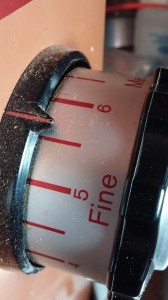 Grind – If you’ve been with me for awhile, you know I advocate erring a notch coarser when using most brewers. But I also advise playing around with grind and, once in a while, it pays to just experiment a notch at a time. For instance, with this brewer I go one notch finer. That may be because I don’t usually make a full 8-cup batch, but rather fill the water only to the 1 liter mark. Just so you understand the testing procedure for SCA certification, brewers must make their coffee, start to finish, within six minutes. So when you make approximately 25% less, it’s likely that it will be a little rushed traveling through the grounds. I’ve found by grinding slightly finer I slow the drip rate and this increases brew strength. If I make a full batch I coarsen the grind slightly.
Grind – If you’ve been with me for awhile, you know I advocate erring a notch coarser when using most brewers. But I also advise playing around with grind and, once in a while, it pays to just experiment a notch at a time. For instance, with this brewer I go one notch finer. That may be because I don’t usually make a full 8-cup batch, but rather fill the water only to the 1 liter mark. Just so you understand the testing procedure for SCA certification, brewers must make their coffee, start to finish, within six minutes. So when you make approximately 25% less, it’s likely that it will be a little rushed traveling through the grounds. I’ve found by grinding slightly finer I slow the drip rate and this increases brew strength. If I make a full batch I coarsen the grind slightly.
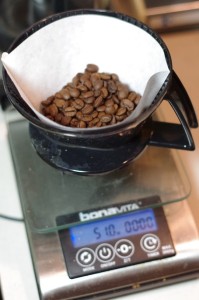 Recipe Measurements – Consider that we may have gone from using too few grounds to using too many. Maybe this brewer does such an efficient job it does not need the requisite 55 grams specified for a liter of coffee. If you make one liter, I suggest you try using 50-51 grams. I found this to be the best recipe. I discovered this by accident as I only had 50 grams left of a particularly memorable ReAnimator coffee when a friend arrived for a visit and a cup. Since I needed to make one liter, I decided to chance it. To my surprise I preferred it using this formula.
Recipe Measurements – Consider that we may have gone from using too few grounds to using too many. Maybe this brewer does such an efficient job it does not need the requisite 55 grams specified for a liter of coffee. If you make one liter, I suggest you try using 50-51 grams. I found this to be the best recipe. I discovered this by accident as I only had 50 grams left of a particularly memorable ReAnimator coffee when a friend arrived for a visit and a cup. Since I needed to make one liter, I decided to chance it. To my surprise I preferred it using this formula.
Pre-infusion – This brewer has a pre-infusion stage, which drips a few ounces of water over the grounds to saturate them before the majority of water is released and dripped over the grounds. I strongly recommend using it if your coffee is fresh, meaning just a week or two from its roast date. If your grounds are older than this, or you use pre-ground coffee, you may skip this stage, although it won’t hurt, so if in doubt, use it. Its purpose is to allow the coffee to de-gas, which prevents foaming up and potentially spilling over the filter holder’s top edge. Pre-infusion also allows it to de-gas and settle down before the majority of water drips through, which actually helps facilitate the extraction process.
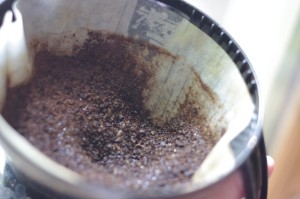
Filter holder – If there’s one area where manual drip still reigns supreme it is the end user’s manual water dispersion over the grounds and subsequent even extraction. Fortunately, the Bonavita already does a good job dispersing the water. But, for a perfectionist end-user, we are able to occasionally swivel the filter holder to vary the showerhead’s position over the grounds. This is kind of tweaky, but shows to what extent I’ve played with mine over the years. I would not expect this tweak to make a night and day difference with this maker, but it is a slight tweak and just goes to ensure that all the grounds get wet. If someone told me this is too far to go to make coffee, I’d likely agree. But, I do it. Look at my “after” photo of the grounds post-brewing and see if yours matches. Again, if it’s too much, skip this if you like.
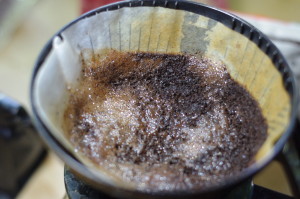
I define tweaks as anything I do beyond the instruction manual, that appears to make a better pot of coffee. This brewer is noteworthy in that none are necessary for it to perform its stuff. But, I’m comparing to the best manually brewed coffee I’ve ever had. That fact that it’s that close to perfection already is impressive. I simply believe I can match that perfect flavor with this brewer, with just a little attention to details.
What are your tweaks?
Podcast: Play in new window | Download
Subscribe: Android | Email |
by Coffee Kevin | Apr 13, 2016 |
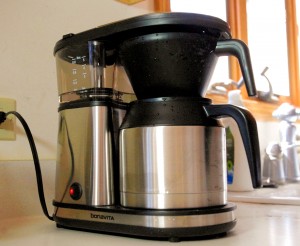 Bonavita practically owns what might have once been called “The Chevy” market. This meant, again at one time, a good quality, well designed product that was easy to use and maintain. It had no stunning features, but was priced for everyman. I suppose in automobiles Chevy has been replaced by Toyota, or recently, Hyundai.
Bonavita practically owns what might have once been called “The Chevy” market. This meant, again at one time, a good quality, well designed product that was easy to use and maintain. It had no stunning features, but was priced for everyman. I suppose in automobiles Chevy has been replaced by Toyota, or recently, Hyundai.
Bonavita hit the marketplace with a Melitta-designed 8 cup coffee maker. It was known as a lower-priced Technivorm but that’s really not the truth. It was a lower-priced Technivorm that increased the water spray width to better match the grounds basket width. Generation 2 Bonavita brewers (no longer designed by Melitta) went further by adding pre-infusion features and switched to flat bottom filters, all in the pursuit of better cup quality. Bonavita gets good marks in the consumer press, including this blog.
Recently, Bonavita brought out this model, which is for the growing medium batch market. Households with two coffee drinkers don’t need eight or ten cups each time they brew. Consumers have realized that fresh is best, and in my home, I brew a couple of cups for each of us each morning. If we are home and wish a repeat dose after lunch or later, we simply repeat the process. It reduces waste too. I pay roughly $20 per pound for specialty beans and, believe me, I cringe whenever I see leftover coffee go down the drain.
The Bonavita 5-cup returns to their Melitta roots with the use of a V-shaped cone filter. They used a number 4 filter, which Bonavita, ever the practical company determined was the easiest to find, plus it gives the coffee plenty of room to expand, which truly fresh coffee does in the first few minutes of brewing. I assume a V-shape was chosen to increase saturation and slow brewing slightly. With an 8-cup brewer, there’s a concern about the brewing happening quickly enough, so that the grounds are not over-extracted. With the smaller batch of a 5-cup, the opposite is true. All drip machines are a carefully thought-out process where grind, volume and time are matched to create the ideal extraction. So, whenever I test a new different-size batch coffee maker, even from a manufacturer of another machine, I spend a fair amount of time playing with the variables I as consumer have over the process.
For instance, I initially tried a grind similar to what the Bonavita 8-cup uses. I found this was the most important thing to tweak. This is not specific to this brewer, but the shorter the contact time, the precise grind needs to be, in my experience. I played with typical cone Melitta-style grinds and finally ended up using a somewhat coarser grind. Not as coarse as Chemex, but definitely coarser than I’d use for most cone filter machines. I also settled on 42 grams of coffee to deliver a cup of coffee I could really enjoy.
The Bonavita 5-cup also has a pre-infusion stage which is easy to implement. You simply hold the on button in place for a few seconds. Once it blinks, simply release it and press it on again. Every time you start it the pre-infusion stage will work until you physically unplug it. This stage is important to anyone who uses coffee two weeks from roast, which is how I do it and I assume you do too. It’s technically known as “fresh coffee”. Of course I’m also assuming we’re all fresh grinding it seconds before we brew.
Consistent with the whole 1960 Chevy concept Bonavita doesn’t waste time with metal filters, on-board water filters, alarm clocks or other non-essential frills.
How does it test? I measured the temperature right at the hot water exit holes. It is slightly lower in temperature than I expected. It peaks at near 200°F, 199°F to be exact. The first minute was spent climbing “to altitude”. While not seeming ideal, it probably matches many slow brew methods in practice. Most people who use a Chemex may not measure their brewer’s temperature, but sub-200°F temperatures are quite common in practice. It doesn’t really bother me, but it did bother the SCAA, who held to their exact temperature specs their certification program demands.
A non-certification test, but one I consider critical and a hallmark of every other Bonavita brewer I’ve yet tested is the water dispersion, which is truly excellent with this machine. Dispersion is geek-speak to describe what happens when a skilled barista constantly surveys the grounds in your Chemex and makes sure the water covers the grounds, ensuring there are no dry spots and that all the grounds receive equal saturation. In practical terms this means you get strong flavor that is less bitter, than it is if you concentrate the water too much on one particular spot.
The contact time between the hot water and the grounds is slightly under 5 minutes. This is at the short end of the SCAA brewing specification of 4-6 minutes for drip. Again, I could get all sniffly about it, but I found that it was not a problem. If I were to guess I’d say the aforementioned water saturation is so efficient it accomplishes the right amount of extraction in less time.
A note about temperatures: I think the range of 196° to 205°F called for in the SCAA standards (themselves adaptation of the original Pan American Coffee guidelines developed many years ago) are reasonable. I agree we need to start somewhere, but there’s also a big difference between a brewer that misses the mark by a degree or two, while still meeting other criteria versus ones that don’t seem to even try, frankly, most of the ones out there made by the largest small appliance makers.
Taste tests:
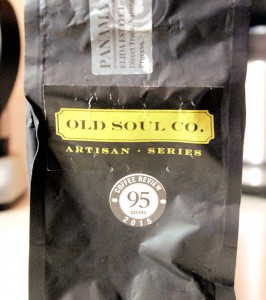

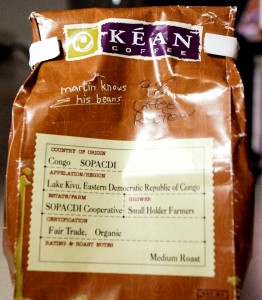
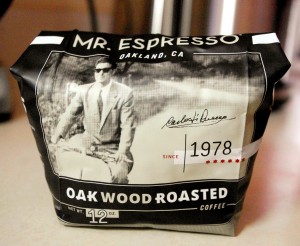
Test 1 – I made a batch using Groundwork Coffee’s Organic Rwanda, they’d been kind enough to share with me at CoffeeCon LA. I already enjoyed it in my Bonavita BV1900S, but I made it improperly in this first outing. Although the coffee had the same notes, everything was out of balance, and auspicious beginning. I realized I’d used 44 grams (still not sure why) and a medium coarse grind as I would in an 8-cup flat bottom brewer. I’m only reporting it because I can’t say enough about how important it is to use the right recipe.
Test 2 – Next, I was able to snare Old Soul Coffee’s Panama Elida Estate Lot #13, which was rated 95 by Ken Davids in The Coffee Review. What a fruit bomb! Fortunately I backed off the recipe to just about 42 grams. What a difference! I strongly recommend this coffee to anyone who’s convinced that the recent Panama Geisha invasion is only attributed to the Geisha bean. While I’m a fan of Geishas, this coffee proves a Panama coffee can be stellar and not be Geisha. This one isn’t a Geisha, but it’s delicious.
Test 3 – Kean Coffee’s Congo Lake Kivu is a rarity for me. I’ve never before had a Congo coffee. I guess I’ve been missing a lot. This coffee, selected and roasted by Martin Diedrich, is not only a wonderful bean, but Martin is not afraid to roast it just a shade darker. It suits this brewer perfectly. I had trouble trying anything else after I’d tasted this.
Test 4 – Finally, I received a Sumatra Mandheling from Mr. Espresso in Oakland. John DiRiuocco uses a wood fired roaster. I know nothing professionally about roasting, but I do know how heat is applied makes a difference. That and a honey roasted Sumatra made for an interesting sample. I’d brewed tests of this coffee (and compared them to an Oren’s Daily Roast Mandheling I also had in stock) and discovered I preferred it brewed near the 195°F mark, so it was a good fit for this brewer. I used 42 grams medium finely (#12 grind on my Baratza Encore grinder). I felt I’d finally arrived at the perfect intersection of coffee bean, recipe and grind setting, the holy trinity of good automatic drip brewing.
Previous review note: I make it a policy never to read other reviews while mine is in progress. I had seen this one however and I noticed CNET’s reviewer (Brian Bennett) noted a bitter taste. I’m not sure what the difference was, but I was unable to produce a bitter coffee during any testing of this machine, which was over a one month test period. Two test results I tested and reported that could cause bitterness, temperature and contact time, are both at the low end in this machine, so that are unlikely (ne impossible) to produce this result. Other factors could be his choice of beans, which he did not identify. I only test using lighter (Third Wave style) high end specialty beans, in this case two of our samples were brewed using beans rated in the mid 90s in the Coffee Review. No bitterness whatsoever. I’m unaware of other factors that would result in bitterness. Maybe he needs to check his water supply. If Mr Bennett wants to contact me, reveals his bean choices and discuss other possible causes, I’d be happy to share them. I’m befuddled by his claim. In any case I didn’t find cause to be concerned and I suggest it’s unlikely under your conditions.
Conclusion: I’m getting spoiled lately. Between my manual drip methods, and some ultra-sophisticated automatic drip brewers which feature multiple brewing temperatures, which is one reason I was able to simply match up a coffee to this one’s brewing temperature range. However, those machines are larger and costlier, both in base price and coffee to keep it going (think gas mileage). The Bonavita 5-cup makes four/five delicious cups of java. Consider that the smaller the batch size and brewing time, the more precise you must be in measuring your coffee grounds and grind. That said, I could easily live with this brewer. If you want a trouble-free, easy to use, no frills but high quality brewer to make fresh specialty coffee for you and a friend, the Bonavita BV1500S five cup is a good choice.
by Coffee Kevin | Mar 16, 2016 |
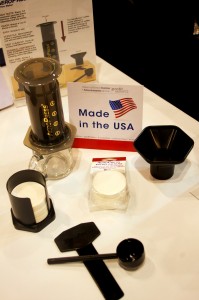 The International Housewares Show is another important trade show for coffee, yet it seems to attract few other coffee journalists. Why? I assume it is because many writers are still stuck thinking coffee is just another beverage ala wine or beer. Those items are brought to their final greatness, then sealed in packages until consumers open and drink them. Period. Coffee is different and a key to its greatness is the final brewing step. At a café, this is someone else’s challenge. At home, where 70% of it is consumed according to the National Coffee Association, the brewing equipment is an obvious dramatic ultimate creator of coffee flavor as it conducts the alchemy which extracts the glorious complex notes from our prized coffee beans. This year’s Housewares show featured a number of important pieces of gear that those of us who know of brewing’s role, will find beneficial to our quest to enjoy the world’s best coffee at home. Here’s my short list:
The International Housewares Show is another important trade show for coffee, yet it seems to attract few other coffee journalists. Why? I assume it is because many writers are still stuck thinking coffee is just another beverage ala wine or beer. Those items are brought to their final greatness, then sealed in packages until consumers open and drink them. Period. Coffee is different and a key to its greatness is the final brewing step. At a café, this is someone else’s challenge. At home, where 70% of it is consumed according to the National Coffee Association, the brewing equipment is an obvious dramatic ultimate creator of coffee flavor as it conducts the alchemy which extracts the glorious complex notes from our prized coffee beans. This year’s Housewares show featured a number of important pieces of gear that those of us who know of brewing’s role, will find beneficial to our quest to enjoy the world’s best coffee at home. Here’s my short list:
Behmor’s Joe Behm has single-handedly driven the coffee brewing world to new heights. Before Joe, the brewing world seemed to sit on its collective hind end and got hung up adding alarm clocks other useless features to its products. Joe created the first multiple temperature brewer, the first once since the lengendary Chemex Automatic that had pre-infusion (for fresh-roasted/fresh-ground coffee). Joe’s Behmor brewer was the first I ever tested that acknowledged the fact that anyone living in high-altitude cities wasn’t able to brew at near ideal water temperatures and added an attitude setting. This past year, Joe became the first one to issue a coffee brewer that can be operated by your smart phone. Before you say, “so what?” and wags issue lame jokes about our modern society not being able to press the “on” button, let me quickly explain what this really means. It means being able to control many variables too numerous to accomplish simply by adding buttons. It means taking advantage of the phone’s better interface to those features, which will soon include not only brewing temperatures and pre-infusion times, but things heretofore only available to manual craft brewers, such as rest periods between pours during brewing. 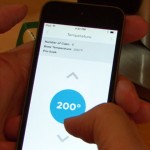 Best of all, and most important in my view, is the connected feature that lets your favorite roasters upload their own personal favorite brewing parameters to the Behmor website. Let’s explore this scenario: Let’s say Jeff Duggan at LA’s Portola roasters decides that his latest Panama Geisha is ideally brewed at a temperature of 197°F. When it’s brewed within its ideal window of fourteen days from roast, it requires a 1 ½ minute pre-infusion of water to settle the grounds before brewing starts; after that it does best with a fifteen second spacing between pours throughout the brew cycle. Then Jeff uploads those parameters to the Behmor web site, aside other similar instructions for various beans. You go there using your phone app, download it and press go. The Brazen Connected brewer just went from being one of the most extensive to use to being one of the simplest. That’s why it’s important.
Best of all, and most important in my view, is the connected feature that lets your favorite roasters upload their own personal favorite brewing parameters to the Behmor website. Let’s explore this scenario: Let’s say Jeff Duggan at LA’s Portola roasters decides that his latest Panama Geisha is ideally brewed at a temperature of 197°F. When it’s brewed within its ideal window of fourteen days from roast, it requires a 1 ½ minute pre-infusion of water to settle the grounds before brewing starts; after that it does best with a fifteen second spacing between pours throughout the brew cycle. Then Jeff uploads those parameters to the Behmor web site, aside other similar instructions for various beans. You go there using your phone app, download it and press go. The Brazen Connected brewer just went from being one of the most extensive to use to being one of the simplest. That’s why it’s important.
Bonavita is distributed by Espresso Supply. This is good because Espresso Supply has very close contact with many roasters, some who’ve become for the first time comfortable carrying and endorsing an electric home automatic drip brewer. The public too, has become very comfortable with SCAA industry-certified automatic home brewers thanks to Espresso Supply. They distribute Bonavita gear and make some of their own. They also introduced two reusable K-cups, a plastic one made in the USA and a stainless version not made in USA. I snared a sample and will test it soon. A new Bonavita 5-cup brewer is undergoing my testing right now.
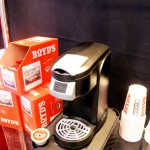 Boyd’s Coffee Company distributes Behmor, and so shared their booth with Joe Behm and with their own TechniBrew International brand. Boyd’s is an unusual coffee company because they are a large wholesaler and coffee brand, especially strong in the Pacific Northwest, but also employ engineers and have a piece in other coffee brewers. One, which I think they own but are branding through the name TechniBrew (they used to be the Technivorm’s US distributor) is a K-cup pod brewer. Before this publication’s fans stop reading, you should know that this one possibly deserves your attention for two reasons. First, although I have not yet officially tested it for review, Boyd’s designed it to fully meet industry brewing standards. I’ve tested one other K-Cup pod brewer that claimed this (made by Bunn) and that unit did prove to me that much of the coffee aficionado’s distaste for this format is due to lackluster brewers that use it, not the format itself. Inventor/Engineer Dave Wheeler of Boyd’s told me the TechniBrew K-cup brewer will meet all SCAA Brewer certification standards. Please note: The SCAA does not review nor certify K-cup brewers. In a casual tasting at their booth, I must say I did find the coffee of a different level than with other K-cup brewers, but of course that is a totally unscientific and anecdotal comment. Boyd’s also designed their K-cup products so they are 100% compostable. From an environmental point of view, this is even more significant.
Boyd’s Coffee Company distributes Behmor, and so shared their booth with Joe Behm and with their own TechniBrew International brand. Boyd’s is an unusual coffee company because they are a large wholesaler and coffee brand, especially strong in the Pacific Northwest, but also employ engineers and have a piece in other coffee brewers. One, which I think they own but are branding through the name TechniBrew (they used to be the Technivorm’s US distributor) is a K-cup pod brewer. Before this publication’s fans stop reading, you should know that this one possibly deserves your attention for two reasons. First, although I have not yet officially tested it for review, Boyd’s designed it to fully meet industry brewing standards. I’ve tested one other K-Cup pod brewer that claimed this (made by Bunn) and that unit did prove to me that much of the coffee aficionado’s distaste for this format is due to lackluster brewers that use it, not the format itself. Inventor/Engineer Dave Wheeler of Boyd’s told me the TechniBrew K-cup brewer will meet all SCAA Brewer certification standards. Please note: The SCAA does not review nor certify K-cup brewers. In a casual tasting at their booth, I must say I did find the coffee of a different level than with other K-cup brewers, but of course that is a totally unscientific and anecdotal comment. Boyd’s also designed their K-cup products so they are 100% compostable. From an environmental point of view, this is even more significant.
It’s a little known fact that Brewista is the brainchild of Brian Gross, likely as close as the coffee world has to a Henry Ford. Brian is a genius and inventor. He is co-owner of BonaVita, whose coffee makers are the current everyman’s favorite, but created Brewista as if he became bored with owning just one great company. Brewista even seems to compete with Bonavita on some levels, something I can’t say I understand. Brewista makes the only coffee brewer other than AeroPress which is made in the USA, Cheyenne, Wyoming to be precise. It’s called the Brewista Steeping Filter, and it is a hybrid steep and drip manual pourover. They’ve also got a number of kettles, scales, and other gear. While Brian seems to be aiming Brewista to mostly be lower-cost Bonavita equivalent gear, he revealed an inventive variable spout kettle that allows the user to control flow and thrust. I know of at least one prominent end user who eschews goose-neck kettles for his Chemex pours because he can’t get enough flow and power in order to “push the grounds around” (their words). Most interesting to me is that Brian is developing different paper filter grades to appeal (I think) to different folks’ tastes on filter. More on that as I learn more from Brian. If you listen to the podcast clip you’ll understand why I can only process a percentage of Brian’s mind while he’s on a roll.
Bunn exhibited a newer, simplified and less expensive single cup Trifecta. They’ve taken their previous two buttons, one controlling time and the other turbidity (using air blown through the brew chamber to stir things up) and made a single button that combines the two. While I despair at losing any functionality of this brilliant and unique machine (both Bunn’s commercial and home marketing teams really blew it in my humble opinion), I think the single button might be justified if it brings the Trifecta into spitting price distance of say a Technivorm, whoops – MoccaMaster. Coleman Garcia brought several new
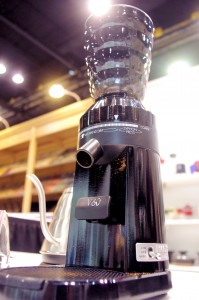 Hario products to IHA. One was actually premiered at CoffeeCon LA in January, well ahead of this trade event. It’s a programmable infrared heater for the Hario Siphon. While their previous product is functional and makes a compelling statement to the already visual home theater experience of making coffee, this new unit offers a touch screen and it’s able to record user information, including the ability to record and repeat your personal siphon brewing method and timings, making it even more beautiful. Suggested retail pricing will be $500. It is awaiting US approvals, but I predict it will be a big seller among this method’s fans. Hario has introduced metal V60s and accompanying matching black, gold and silver aluminum stands. I may be fine with my plastic version, but I also expect these to move into home setups soon. They had their already-well known Mizudashi Immersion cold coffee Brewer there as well. Finally, Hario introduced a home grinder, optimized to accompany and even grind directly into a V60 cone. It also features front panel indicators for Press, V60 and Siphon. While Coleman humbly referred to it as a brand extension, I can imagine a lot of interest as their core audience is sophisticated enough to appreciate a grinder and has a fervent interest in any product labeled Hario, similar to the Apple brand allure.
Hario products to IHA. One was actually premiered at CoffeeCon LA in January, well ahead of this trade event. It’s a programmable infrared heater for the Hario Siphon. While their previous product is functional and makes a compelling statement to the already visual home theater experience of making coffee, this new unit offers a touch screen and it’s able to record user information, including the ability to record and repeat your personal siphon brewing method and timings, making it even more beautiful. Suggested retail pricing will be $500. It is awaiting US approvals, but I predict it will be a big seller among this method’s fans. Hario has introduced metal V60s and accompanying matching black, gold and silver aluminum stands. I may be fine with my plastic version, but I also expect these to move into home setups soon. They had their already-well known Mizudashi Immersion cold coffee Brewer there as well. Finally, Hario introduced a home grinder, optimized to accompany and even grind directly into a V60 cone. It also features front panel indicators for Press, V60 and Siphon. While Coleman humbly referred to it as a brand extension, I can imagine a lot of interest as their core audience is sophisticated enough to appreciate a grinder and has a fervent interest in any product labeled Hario, similar to the Apple brand allure.
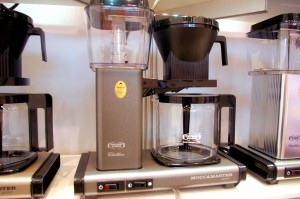 I almost missed them – I keep forgetting that Technivorm is really MoccaMaster. The machines haven’t changed and they likely won’t, and to this brands fans that’s a good thing. MoccaMaster stubbornly refuses to embrace frivolous new features, although some of them in my opinion contribute to taste, but no one can deny they make a great product. They are still hand-built in the Netherlands. They have stuck to all copper heating elements, arguably the best and safest to health. Oh, there is a new color one to add to their array of beautiful ones. A beautiful machine in a geeky way.
I almost missed them – I keep forgetting that Technivorm is really MoccaMaster. The machines haven’t changed and they likely won’t, and to this brands fans that’s a good thing. MoccaMaster stubbornly refuses to embrace frivolous new features, although some of them in my opinion contribute to taste, but no one can deny they make a great product. They are still hand-built in the Netherlands. They have stuck to all copper heating elements, arguably the best and safest to health. Oh, there is a new color one to add to their array of beautiful ones. A beautiful machine in a geeky way.
While all pod machines presume unproven assertions that pre-ground coffee can be kept fresh in those pods, both Nespresso and Illy pod machines have proven to my taste buds that they are capable extractors of taste, given you like the taste they are engineered to deliver. This year, Nespresso has added the connected feature, meaning you can use and app to program, start and keep track of onboard pod inventory with your smart phone.
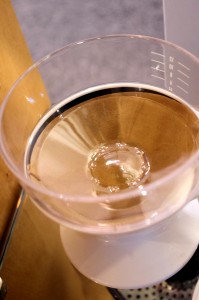 The 12-cup OXO brewer I reviewed recently was getting a lot of attention. Last year OXO brought prototypes and this year they’re all working and their two top brewers earned SCAA certification. To me, the pride of earning this honor with your first machine and one that is able to make 12 cups is noteworthy. OXO’s grinder is also noteworthy because theirs equals a higher priced Baratza grinder (in our grind results tests). One brewer they had that’s spanking new was the OXO Autodrip pourever coffee maker, which makes 6 – 12 ounces of brewed coffee using an innovative cup-marked overhead water reservoir to eliminate guesswork, and which also have a dozen smaller drip holes in order to spread the shower over the grounds. OXO’s Dave Lionetti also told me they’ve played with alternating size and patterned drip holes, which he says enhances the way water falls, agitates and steeps the grounds, which results in a better tasting cup of coffee.
The 12-cup OXO brewer I reviewed recently was getting a lot of attention. Last year OXO brought prototypes and this year they’re all working and their two top brewers earned SCAA certification. To me, the pride of earning this honor with your first machine and one that is able to make 12 cups is noteworthy. OXO’s grinder is also noteworthy because theirs equals a higher priced Baratza grinder (in our grind results tests). One brewer they had that’s spanking new was the OXO Autodrip pourever coffee maker, which makes 6 – 12 ounces of brewed coffee using an innovative cup-marked overhead water reservoir to eliminate guesswork, and which also have a dozen smaller drip holes in order to spread the shower over the grounds. OXO’s Dave Lionetti also told me they’ve played with alternating size and patterned drip holes, which he says enhances the way water falls, agitates and steeps the grounds, which results in a better tasting cup of coffee.
Those are highlights. I reserve the right to add more if I think of them, but those stood out and, once again, Housewares proves to be a great place for coffee brewing products. #Housewares 2016.
by Coffee Kevin | Apr 24, 2015 |
 I keep saying we’re living in a golden age of coffee brewing. This year’s Seattle SCAA Event brought more brewers. There are even a few coffee discoveries to report. Here are some highlights:
I keep saying we’re living in a golden age of coffee brewing. This year’s Seattle SCAA Event brought more brewers. There are even a few coffee discoveries to report. Here are some highlights:
Nick Kohout of Arcaia showed me some scales that, frankly, did not impress me at first. I mean, they supposedly have some higher-end parts than comparable Bonavita scales, but does that excite anyone? I’ve had no problems with any Bonavita scales, not that I’m a barista, but I’m just being honest. Then he showed me how its timer keeps track of the contact time in manual brewing. Apparently, it detects when the water has gone through the grounds, and pauses the clock. Now I am excited! Their goal of connecting folks via the web so they can meaningfully compare their brews is also a step in the right direction.
Lots of new coffeemakers, some Kickstarter projects and others already developed and seeking coffee stores to recommend and sell them to customers. Gregory Bombeck’s Phoenix coffeemaker was one. Another was the Kinto coffeemaker from Japan. Saint Anthony Industries has one of the most beautiful cold brew makers I’ve yet seen, although the whole cold brew thing leaves me… oh, I won’t say it.
My own personal favorite was from 21 year-old Cameron Hughes of Invergo Coffee, of Garden City, New York. His brewer’s patented swiveling spray head may have cracked a problem that’s plagued automatic drip makers since George Bunn introduced the first Bunn-O-Matic in the 1950s, and that is how to effectively mimic the way you and I pour water so beautifully by hand. He also claims you can set the brewing temperature, not revolutionary, but makes me want to test his machine in my kitchen. My at-show tasting was compelling however. Remember, Orson Welles was twenty one when he became famous in radio. Post-moderns may prefer a Beatles analogy.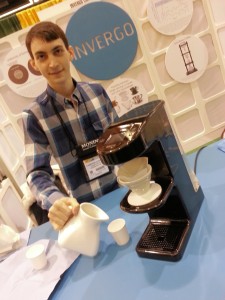
At the Remarkable Indonesia pavilion, they were tasting some interesting coffees. It’s no secret that I’m a fan of this country’s coffees. The flavor diversity is astounding, and I can only assume that it’s distance and the fact the only a select few green buyers (think Geoff Watts) ever makes the trek (20 hours-plus) to actually visit. My personal taste favorite was Bali coffee. I admit I have a guilty pleasure for some of their robusta varieties as well. But the news this year was their showing clips of a new film, Aroma of Heaven, created, written and lensed by cinematographer Budi Kurniawan. Budi K, as he introduced himself, is almost as interesting as his film. A compulsive shooter, he had a camera in his hand both times I’ve seen him. I predict this film will be a big hit among coffee enthusiasts. It deserves special mention for being the first film to not seem like a colonialist perspective, but rather an honest, if not bitter, but also not candy glossed look at coffee. Indonesia goes pretty far back in coffee history, by the way. Budi says a download is going to be available, but I’m pitching for some neighborhood showings (I know someone at CoffeeCon hehe). It’s a remarkable film, and thanks to a screening of it in entirety) I speak with confidence.
I’ve been trying to track down Breville products for reviews for years. Fortunately, a changing of the guard has opened transparency and Category Manager Alejandra Lin has pledged to get us some of their products that are promising. I’ve heard good things about their grinders, but talk (especially about grinders) is cheap. Let’s get one and do some measurements, which is what matters. Breville really had something that caught my attention. Alejandra told me their automatic drip maker has the ability to modify its contact time according to volume. As you may know, most automatic drip makers’ contact time between the grounds and hot water is optimized for one specific cup size, usually, but not always, the maximum. Make more coffee, it’s too strong/bitter. Make less, it’s weak/undeveloped. If the new Breville machine delivers, it will be front page news (here anyway!).
The show surprise was this new stovetop coffee roaster. Jung Park of Dr Mahn Coffee brought his new design from Korea, which seems to be experiencing a coffee renaissance of new innovations. Can’t wait to try it, remembering both the 1990s Palani Pan roaster and the importance of a kitchen fan when roasting over fire. What this country needs is a simple professional quality sample roaster on par with the classic Siemans Sirocco coffee roaster long out of production (spotted one last week on eBay, which was snapped up before I could say “Buy it Now”. I think I may have found it. Luke Kawa of Kawa Coffee had one, which is also extremely attractive, but how it roasts will be what interests me most, of course.
Remember a Netherlands company named Bravilor? They used to be distributed by Boyds. I always thought of them as a commercial version of Technivorm. They are about to introduce a consumer automatic drip coffeemaker. Seemed very robust, but not coffee samples at SCAA. Might be ready by CoffeeCon Chicago in July, according to Eric Covelli, Bravilor Marketing
VP. Had a delightful dinner with Kenneth Davids, famous author of many books on our favorite subject. One of our topics was the current Geisha coffee craze. According to Professor Davids, there are genuine attributes to the Geisha cultivar. One such sample (roasted here in Chicago by Big Shoulders) earned a whopping 96 rating in a recent CoffeeReview.com tasting.
Bonavita had their latest 5-cup maker and many other products on display. They’re an amazing coffee maker success story. I’m particularly interested in this size category because as more people buy specialty (read: expensive) beans, they’re going to take a closer look at over-brewing those twelve cups, when they each have a couple (read: 4). Marcus Boni assured me a sample will be sent and, of course, a review will result.
Jim Shanley is a farmer with a unique geographic location. He’s in California and his farm is aptly titled, California Coffee Farms, the first I know of in the continental 48 states. Hopefully I will try some soon.
Robin Thorum spoke to one of my favorite subjects, testing grinders. Mr Thorum’s company has done a lot of research on measuring irregular objects such as coffee grounds. According to him, laser measuring tools presume all ground particles to be spherical, which would be nice, but anyone can see this is not so. Ditto traditional sieve tests, where oblong grind particles outsmart screens and slither through, which gives inaccurate comparisons. What we want to measure of course is surface area. He claims his company, Coffee Laboratory, has developed a better, more accurate way to measure this surface area.
At the expense of getting a little sniffly, there were several awards given to longstanding coffee industry members that deserve mention here. First, Carlo Di Riocco, whose Mr Espresso is the curator of what many of us consider the true Italian espresso. Di Riocco started as an engineer, but combined his insistence on consistency with art. I compel anyone to find a finer drink. He’s also kept doing the right thing against various fads in espresso roast, preparation and serving, a combination that’s kept his product unique.
Oliver Strand was able to do what no other comparable media personality has, and that’s bring coffee to the pages of a big city newspaper, in this case the New York Times. The coffee people I know don’t always agree with him, but that fact is they read everything he writes. So do mainstream readers and that’s what’s most important. If coffee is really the next wine it needs to enter culinary arts columns nationwide. The best part to me is he is real. He really is a coffee enthusiast, not a poseur. I still cringe when I view how coffee has been presented on the Food Network.
Finally, La Minita’s Bill McAlpin was the first person I called after I read a Corby Kummer Atlantic article about coffee. After hearing my own enthusiasm for coffee and wanting to learn and write about it, spent an hour or more discussing it with me, and even introduced me to Ken Stevenson and others so I could get a proper education. I’ve met no more generous person than him in the years I’ve been a coffee scribe. The fact that La Minita defined what is now called a specialty coffee farm is possibly of equal importance. Oh yes, and the coffee is always great! Bill McAlpin was finally properly honored this year. I was surprised to see the outwardly cooler McAlpin get glossy-eyed while receiving his award. Mr Espresso seemed to foster a trend, making these normally staid awards a three-hanky one. Even I wasn’t immune from tearing up a bit seeing these greats get their just acknowledgement.
Finally, we surprised to see OXO, seemingly moments after the Chicago International Housewares Show. Claire Ashley and her team brought their new coffeemakers and accompanying grinder, which features a built-in scale. Lots of folks whispering about it, as I think it shocks them to think a large housewares company (admittedly mostly unpowered) might enter the coffeemaker sweepstakes. I keep telling folks, brewers are the power behind the glory in every great cup of coffee. Great job, SCAA. Another fun and productive trade event.
by Coffee Kevin | Jan 25, 2015 |
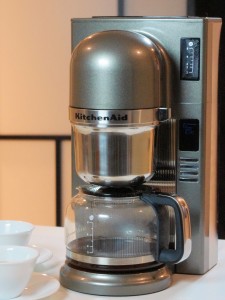 KitchenAid’s new 8-cup automatic drip Coffeemaker is proof that appliance manufacturers now take coffee making parameters as seriously as they do any culinary art. KitchenAid has long been a coffee innovator, with high build quality and within reasonable price points. This new model has literally been years in the making.
KitchenAid’s new 8-cup automatic drip Coffeemaker is proof that appliance manufacturers now take coffee making parameters as seriously as they do any culinary art. KitchenAid has long been a coffee innovator, with high build quality and within reasonable price points. This new model has literally been years in the making.
I visited them during summer 2012, during which time their four person design team held a therapy session, where I lay back and told them everything missing from most coffeemakers. Just kidding about that part, but suffice it to say, I left feeling unburdened and they went to work building it.
Sure enough, they brought it to this year’s CoffeeCon San Francisco and Los Angeles events. I recall making a beeline to taste a cup. It was good enough that I requested a model for my long-term at-home tests, from which I made review judgments.
This KitchenAid model has several important features:
• Pre-infusion stage. It dribbles a small amount of water, pauses to allow ultra fresh coffee grounds to get wet and exhale their carbon dioxide.
• Intermittent brewing throughout the brewing process, just like you instinctively do using a manual drip coffeemaker. We’ll talk more about this in in a moment.
• Two brewing temperatures. A higher one is just over 200°F, and optimized for lighter roasted (most Third Wave) coffees. The second, lower temperature setting stays under 200°F and is optimized for darker roast coffees. It’s up to you of course, as it’s so cutting edge that there’s hardly consensus on this subject. Suffice it to say, it’s amazing to see a big brand acknowledging the standards and then going a step further by offering you a choice of two brewing temperatures within those standards. Again, this is sophistication on par with manual brewing geeks.
• Perhaps the biggest news is that the KitchenAid meets SCAA (Specialty Coffee Association of America) brewing guidelines, which are stringent. This means a temperature spec (range: 196°-2015°F), within the given drip time spec of 4-6 minutes.
• Cup number setting. This at least promises to be an attempt to prefigure brewing algorithms so you and I don’t have to. More later, but this just might be their most important feature – if it does what it I think it promises.
First, let’s get this out of the way at the start – most so-called automatic drip brewers are one size brewers that are, by modern standards, not very automatic. If you make a full batch, they do well, maybe even very good, but most coffee enthusiasts eventually discover a manual coffee maker makes better coffee, since you have to figure out each parameter. But still, there’s a need for an automatic maker, because everyone, myself included has something else to do other than make coffee. It’s easy to operate. Just choose your cup setting. I had to get used to it, but the first thing you must do is select your desired cup batch size, but pressing plus/minus buttons. Then press whether you want light or dark roast (higher or lower brew temperature). Then hit brew and you’re ready in ten minutes, no matter what batch size.
How did it do in my tests?
Pre-infusion – The KitchenAid does really do this, but it’s still a best guess. As everyone who brews with manual drip brewers knows, this time varies depending upon how fresh your coffee is. KitchenAid designers chose a reasonable pause. It won’t please everyone, but in my tests, it did a good job of allowing most grounds to rise and fall, and then repeating this drip, pause, drip sequence throughout. Only at the 8-cup setting using extremely fresh roasted and freshly ground coffee did I get any foaming that left residue at the top of the brew basket (near showerhead). Most times it was not a problem.
Intermittent brewing – Part of the benefit of continuing to drip, pause and drip throughout the brewing is let all the water drip through before pouring more water onto the grounds. It seems to achieve a better, more thorough extraction. The KitchenAid did not disappoint. I’m sure there are some that will say their manual drip pours are better still, but for many, this brewer will deliver everything they want from their coffee.
Brewing temperature – Here KitchenAid has done itself proud. Its brewing temperature stability is as good or better than most manual drip, especially if you’re using a traditional kettle. If you’re using a kettle with settable temperature, the KitchenAid still matches or exceeds it, but the difference might be unnoticeable. Still, kudos for the two temperature choices and stability.
Cup setting – Many don’t realize that every automatic drip coffeemaker is optimized in contact time for one size batch. Larger batches will take too long, resulting in bitterness/excess strength; smaller batches mean faster (too fast) contact times and resulting weaker brew. This is simple math. If you baked a half batch of cookies and shortened or lengthened baking times, you wouldn’t expect them to taste right, would you? All drip makers, even manual ones have this challenge. KitchenAid seems to do some adjusting of the drip rate inside to accommodate the changing times, so it lessens it. I’d say they’ve make it work overall. The batches I made between four and eight cups were all between four and six minutes in overall contact time (this spec does not/should not count the time the water is heating with no contact). At the two cup setting, the contact time was not long enough. Keep in mind the cup quality may vary between 4 and 6 minutes contact time, but overall I was satisfied.
There are little tweaks you can try such as grinding a notch finer for fewer cups, or simply upping your grounds to water ratios a gram or two. I’ll leave it to others to explore these options. I settled on 6 cups for most of my tests over a month’s use and found it delivered excellent coffee at all settings between 5 and 8 cups, coffee on par overall with my manual drip brewers.
A couple of extra notations:
• The KitchenAid coffeemaker’s sound is quieter than most other automatic drip coffeemakers and its sound is subjectively nicer.
• KitchenAid is to be commended for offering detailed grounds to cup measuring recipes in their well-written instruction book.
• The water input at the KitchenAid’s top is too narrow for my tastes. I occasionally spilled water while filling it. Maybe it’s just me.
• I routinely filled the water tank exactly to the intended batch cups mark, and found the resulting brew on the carafe at brewing’s end was frequently less. I realize this may be caused by steam loss, but I found it works better to always overfill above the water mark.
Here are a few taste test highlights: I was fortunate to pick up a sample of Martin Diedrich’s Kean Coffee at CoffeeCon L.A. It was a slightly darker roast than most Third Wave roasts, and, (gasp) in my opinion, the better for it. It really shined, especially with using the lower (but still SCAA-approved) temperature setting. This kind of coffee really has that chocolate taste (cliché though it seems) and that temperature just seemed to highlight it.
Another treat was Counter Culture’s latest Ethoipian in a new package. This one really called for the higher temperature, but fully matched my expectations, with a fruitiness and acidity this coffee brewer brought forth in all its glory.
A surprise hit of CoffeeCon LA’s roasts was Temple Coffee’s Panama Geisha. Oh my Lord! What a coffee!! I did two batches concurrently. It was so good I went past my limit. The high temperature was my preference, but it did splendidly (albeit differently) in each. Note: I found a perfect formula for me was to make six cups, using 50 weighed grams of beans, medium-fine grind. The slightly less than full batch allowed even the freshest coffees to brew properly, and gave us a perfect way for Pat, I and a friend each have a couple of cups each.
The KitchenAid 8-cup is highly recommended.
 Grind – If you’ve been with me for awhile, you know I advocate erring a notch coarser when using most brewers. But I also advise playing around with grind and, once in a while, it pays to just experiment a notch at a time. For instance, with this brewer I go one notch finer. That may be because I don’t usually make a full 8-cup batch, but rather fill the water only to the 1 liter mark. Just so you understand the testing procedure for SCA certification, brewers must make their coffee, start to finish, within six minutes. So when you make approximately 25% less, it’s likely that it will be a little rushed traveling through the grounds. I’ve found by grinding slightly finer I slow the drip rate and this increases brew strength. If I make a full batch I coarsen the grind slightly.
Grind – If you’ve been with me for awhile, you know I advocate erring a notch coarser when using most brewers. But I also advise playing around with grind and, once in a while, it pays to just experiment a notch at a time. For instance, with this brewer I go one notch finer. That may be because I don’t usually make a full 8-cup batch, but rather fill the water only to the 1 liter mark. Just so you understand the testing procedure for SCA certification, brewers must make their coffee, start to finish, within six minutes. So when you make approximately 25% less, it’s likely that it will be a little rushed traveling through the grounds. I’ve found by grinding slightly finer I slow the drip rate and this increases brew strength. If I make a full batch I coarsen the grind slightly. Recipe Measurements – Consider that we may have gone from using too few grounds to using too many. Maybe this brewer does such an efficient job it does not need the requisite 55 grams specified for a liter of coffee. If you make one liter, I suggest you try using 50-51 grams. I found this to be the best recipe. I discovered this by accident as I only had 50 grams left of a particularly memorable ReAnimator coffee when a friend arrived for a visit and a cup. Since I needed to make one liter, I decided to chance it. To my surprise I preferred it using this formula.
Recipe Measurements – Consider that we may have gone from using too few grounds to using too many. Maybe this brewer does such an efficient job it does not need the requisite 55 grams specified for a liter of coffee. If you make one liter, I suggest you try using 50-51 grams. I found this to be the best recipe. I discovered this by accident as I only had 50 grams left of a particularly memorable ReAnimator coffee when a friend arrived for a visit and a cup. Since I needed to make one liter, I decided to chance it. To my surprise I preferred it using this formula.
















